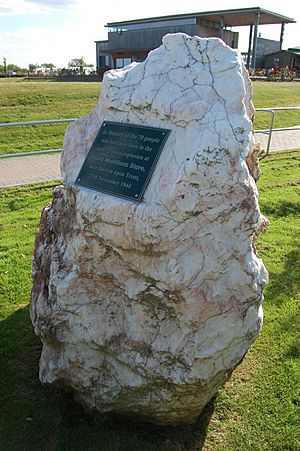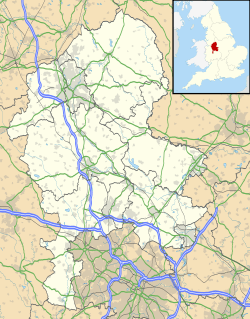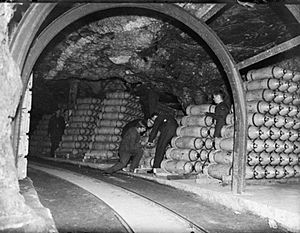RAF Fauld explosion facts for kids
Quick facts for kids RAF Fauld explosion |
|
|---|---|
| Staffordshire, England, UK | |

Aerial view of the crater and damage to the surrounding area caused by the explosion, taken by the RAF on 4 December 1944
|
|
|
Location in Staffordshire
|
|
| Coordinates | 52°50′50″N 01°43′50″W / 52.84722°N 1.73056°W |
The RAF Fauld explosion was a huge military accident that happened on Monday, 27 November 1944. It took place at 11:11 AM at the RAF Fauld underground munitions storage depot in Staffordshire, England. This event was one of the biggest non-nuclear explosions ever. It was also the largest explosion of its kind to happen in the United Kingdom.
About 3,500 to 4,000 tonnes of bombs and explosives blew up. The explosion left a giant hole in the ground, called a crater. It was about 100 feet deep and over 1,000 feet wide. This crater is still visible today, just south of Fauld. It is now known as the Hanbury Crater.
A nearby lake, called a reservoir, held 450,000 cubic metres of water. It was completely destroyed in the incident. Several buildings, including a whole farm, also disappeared. The water from the broken reservoir caused flooding, which added to the damage. Around 70 people are thought to have died in the explosion and flood.
Contents
What Caused the Explosion?
The reason for this disaster was not made public at the time. The British government did not want enemy countries to know how big the explosion was. Years later, in 1974, the cause was finally announced.
There were several problems at the depot before the explosion:
- There were not enough staff working.
- A manager's job had been empty for a whole year.
- Many of the 189 Italian prisoners of war working there were new and did not have much experience.
- There was not enough proper equipment.
- Workers did not get enough training.
- Different groups were working in the mine, which made it hard to have clear orders.
- The British government wanted work to be done faster for the war effort. This meant that safety rules were sometimes ignored.
It is believed that the explosion happened because a worker was trying to remove a detonator from a live bomb. They should have used a wooden tool, but they used a brass chisel instead. This could have caused sparks, which then set off the explosives. An eyewitness said they saw a worker using brass chisels, which was against the rules.
How the Explosion Affected the Area
The storage area was made from old gypsum mine tunnels. It held many types of weapons, including bombs, shells, and millions of small bullets. About 4,000 tonnes of explosives blew up, with 3,500 tonnes being high explosives.
At 11:15 AM on 27 November 1944, two huge explosions rocked the depot. People who saw it said they saw two tall columns of black smoke. These looked like mushroom clouds rising thousands of feet into the sky. There was also a large fire at the bottom of the smoke columns.
Everything within about three-quarters of a mile of the crater was damaged. A farm called Upper Castle Hayes Farm completely vanished. A lime and gypsum factory and nearby cottages were also destroyed. The factory was also badly damaged by the flood after the reservoir broke. Other farms and cottages in the area were heavily damaged too. Even the village of Hanbury had debris and damage. The crater itself was about 300 yards long, 233 yards wide, and 100 feet deep. It covered an area of 12 acres.
People Affected
It is hard to know the exact number of people who died because precise records were not kept. However, it is thought that about 70 people lost their lives in the explosion. The official report said that 90 people were killed, missing, or injured.
The people affected included:
- 26 people from the RAF depot were killed or went missing. These included RAF staff, civilian workers, and some Italian prisoners of war. Five of them died from toxic fumes. Ten others were badly hurt. Six of these people are buried in military graves.
- 37 people were killed (drowned) or went missing at a nearby gypsum mine and plaster factory, and in the countryside around it. Twelve others were injured.
- About 7 farm workers from Upper Castle Hayes Farm.
- One diver was killed while helping with search and rescue.
A memorial stone was put up at the crater in November 1990. It lists 70 names of people who died. Eighteen of these names are people who are still missing and are believed to have died. The explosion also killed 200 cattle. Some cows that survived the blast were found dead the next morning.
What Happened After the Explosion?

Local people started a fund to help the victims and their families. This fund continued to make payments until 1959.
Most of the storage facility was destroyed by the explosion. However, the RAF continued to use parts of the site for storing munitions until 1966. After France left NATO's military structure in 1966, the United States Army used the site. From 1967 to 1973, they stored US ammunition there that used to be kept in France.
By 1979, the site was fenced off. Today, over 150 types of trees and wildlife live there. You cannot easily access the area because a lot of explosives are still buried deep underground. The UK government has decided that removing them would be too expensive.
On 13 September 1990, 46 years after the explosion, it was announced that a memorial stone would be put up. It was paid for by the public. The stone itself was given by the Italian government and flown to the UK by the RAF. It was officially shown on 25 November 1990. A second memorial was dedicated on 27 November 2014, which was the 70th anniversary of the explosion. There is a tourist path that leads to the crater from the Cock Inn pub in Hanbury. This pub was also damaged by debris from the explosion.
Images for kids
See also
- List of United Kingdom disasters by death toll
- RAF munitions storage during WWII




